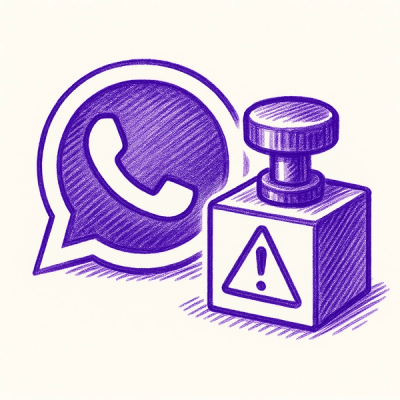
Research
/Security News
Malicious npm Packages Target WhatsApp Developers with Remote Kill Switch
Two npm packages masquerading as WhatsApp developer libraries include a kill switch that deletes all files if the phone number isn’t whitelisted.
@storyblok/vue-2
Advanced tools
Storyblok SDK for Vue 2 to interact with Storyblok API and connect to Storyblok Visual Editor

The Vue plugin you need to interact with Storyblok API and enable the Real-time Visual Editing Experience.
[!WARNING]
Storyblok Vue 2 SDK is reaching its End of Life on August 31st 2024. Please follow the Migration Guide to update your project to the latest version of Vue and Storyblok Vue SDK.
Vue 2 EOL was December 31st, 2023. If you are starting a new project using Vue and Storyblok, please start with the latest version of Vue (3.x) and Storyblok Vue SDK.
Check out the Live Demo on Stackblitz!
If you are first-time user of the Storyblok, read the Getting Started guide to get a project ready in less than 5 minutes.
Install @storyblok/vue-2
npm install --save-dev @storyblok/vue-2
# yarn add -D @storyblok/vue-2
Register the plugin on your application (usually in main.js), add the apiPlugin and add the access token of your Storyblok space:
import Vue from "vue";
import { StoryblokVue, apiPlugin } from "@storyblok/vue-2";
import App from "./App.vue";
Vue.use(StoryblokVue, {
accessToken: "<your-token>",
use: [apiPlugin],
});
That's it! All the features are enabled for you: the Api Client for interacting with Storyblok CDN API, and Storyblok Bridge for real-time visual editing experience.
You can enable/disable some of these features if you don't need them, so you save some KB. Please read the "Features and API" section
Using Vue 2.7
As Vue 2.7 comes with Composition API under the hood you just need to import everything from "vue".
Note:
@storyblok/vue-2v2.0.0 doesn't support Vue 2.6 anymore.
Using Vue 2.6 or less
Use a v1.x.x from this SDK and then, install @vue/composition-api and register it in the application:
// main.js
import VueCompositionAPI from "@vue/composition-api";
Vue.use(VueCompositionAPI);
To use script setup, install unplugin-vue2-script-setup. Depending on your setup, the configuration is different. For example, in Vite:
// vite.config.js
import { createVuePlugin } from "vite-plugin-vue2";
import ScriptSetup from "unplugin-vue2-script-setup/vite";
export default {
plugins: [createVuePlugin(), ScriptSetup()],
};
Install the file from the CDN and access the methods via window.storyblokVue:
<script src="https://unpkg.com/@storyblok/vue-2"></script>
@storyblok/vue-2 does three actions when you initialize it:
storyblokApi object in your app, which is an instance of storyblok-js-clientv-editable directive to link editable components to the Storyblok Visual EditorLoad globally the Vue components you want to link to Storyblok in your main.js file:
import Page from "./components/Page.vue";
import Teaser from "./components/Teaser.vue";
Vue.use(StoryblokVue, {
accessToken: "<your-token>",
use: [apiPlugin],
});
Vue.component("Page", Page);
Vue.component("Teaser", Teaser);
The simplest way is by using the useStoryblok one-liner composable. Where you need to pass as first parameter the slug, while the second and third parameters, apiOptions and bridgeOptions respectively, are optional:
<script setup>
import { useStoryblok } from "@storyblok/vue-2";
const story = useStoryblok(
"path-to-story",
{ version: "draft", resolve_relations: "Article.author" }, // API Options
{ resolveRelations: ["Article.author"], resolveLinks: "url" } // Bridge Options
);
</script>
<template>
<StoryblokComponent v-if="story" :blok="story.content" />
</template>
Check the available apiOptions in our API docs and bridgeOptions passed to the Storyblok Bridge.
You can easily render rich text by using the renderRichText function that comes with @storyblok/vue-2 and a Vue computed property:
<template>
<div v-html="articleContent"></div>
</template>
<script setup>
import { computed } from "vue";
import { renderRichText } from "@storyblok/vue-2";
const articleContent = computed(() => renderRichText(blok.articleContent));
</script>
You can set a custom Schema and component resolver globally at init time by using the richText init option:
import { RichTextSchema, StoryblokVue } from "@storyblok/vue-2";
import cloneDeep from "clone-deep";
const mySchema = cloneDeep(RichTextSchema); // you can make a copy of the default RichTextSchema
// ... and edit the nodes and marks, or add your own.
// Check the base RichTextSchema source here https://github.com/storyblok/storyblok-js-client/blob/master/source/schema.js
app.use(StoryblokVue, {
accessToken: "YOUR_ACCESS_TOKEN",
use: [apiPlugin],
richText: {
schema: mySchema,
resolver: (component, blok) => {
switch (component) {
case "my-custom-component":
return `<div class="my-component-class">${blok.text}</div>`;
default:
return "Resolver not defined";
}
},
},
});
You can also set a custom Schema and component resolver only once by passing the options as the second parameter to renderRichText function:
import { renderRichText } from "@storyblok/vue-2";
renderRichText(blok.richTextField, {
schema: mySchema,
resolver: (component, blok) => {
switch (component) {
case "my-custom-component":
return `<div class="my-component-class">${blok.text}</div>`;
break;
default:
return `Component ${component} not found`;
}
},
});
Inject storyblokApi when using Composition API:
<template>
<div>
<p v-for="story in stories" :key="story.id">{{ story.name }}</p>
</div>
</template>
<script setup>
import { onMounted } from "vue";
import { useStoryblokApi } from "@storyblok/vue-2";
onMounted(() => {
const storyblokApi = useStoryblokApi();
const { data } = await storyblokApi.get(
"cdn/stories/home",
{ version: "draft", resolve_relations: "Article.author" } // API Options
);
});
</script>
Note: you can skip using
apiPluginif you prefer your own method or function to fetch your data.
Use useStoryBridge to get the new story every time is triggered a change event from the Visual Editor. You need to pass the story id as first param, and a callback function as second param to update the new story:
<script setup>
import { onMounted, reactive } from "vue";
import { useStoryblokBridge, useStoryblokApi } from "@storyblok/vue-2";
onMounted(() => {
const storyblokApi = useStoryblokApi();
const { data } = await storyblokApi.get(
"cdn/stories",
{ version: "draft", resolve_relations: "Article.author" } // API Options
);
const state = reactive({ story: data.story });
useStoryblokBridge(state.story.id, story => (state.story = story));
});
</script>
You can pass Bridge options as a third parameter as well:
useStoryblokBridge(
state.story.id,
(story) => (state.story = story),
{
resolveRelations: ["Article.author"],
resolveLinks: "url",
} // Bridge Options
);
For every component you've defined in your Storyblok space, add the v-editable directive with the blok content:
<template>
<div v-editable="blok"><!-- ... --></div>
</template>
Where blok is the actual blok data coming from Storblok's Content Delivery API.
Check out the playground for a full example.
You can use Options API as well, accessing the api client via this.$storyblokApi:
import { useStoryblokBridge } from "@storyblok/vue-2";
export default {
data: () => ({
story: [],
}),
async created() {
const { data } = this.$storyblokApi.get(/* ... */);
this.story = data.story;
},
mounted() {
useStoryblokBridge(
this.story.id,
(evStory) => (this.story = evStory),
{
resolveRelations: ["Article.author"],
resolveLinks: "url",
} // Bridge Options
);
},
};
You can choose the features to use when you initialize the plugin. In that way, you can improve Web Performance by optimizing your page load and save some bytes.
This example of useStoryblok:
<script setup>
import { useStoryblok } from "@storyblok/vue-2";
const story = await useStoryblok(
"blog",
{ version: "draft", resolve_relations: "Article.author" }, // API Options
{ resolveRelations: ["Article.author"], resolveLinks: "url" } // Bridge Options
);
</script>
Is equivalent to the following, using useStoryblokBridge and useStoryblokApi:
<script setup>
import { onMounted, reactive } from "vue";
import { useStoryblokBridge, useStoryblokApi } from "@storyblok/vue-2";
onMounted(() => {
const storyblokApi = useStoryblokApi();
const { data } = await storyblokApi.get(
"cdn/stories/blog",
{ version: "draft", resolve_relations: "Article.author" }, // API Options
);
const state = reactive({ story: data.story });
useStoryblokBridge(
state.story.id,
story => (state.story = story),
{ resolveRelations: ["Article.author"], resolveLinks: "url" } // Bridge Options
);
});
</script>
Check the available apiOptions (passed to storyblok-js-client) and bridgeOptions (passed to the Storyblok Bridge).
You can use an apiOptions object. This is passed down to the storyblok-js-client config object.
app.use(StoryblokVue, {
accessToken: "<your-token>",
apiOptions: {
// storyblok-js-client config object
cache: { type: "memory" },
},
use: [apiPlugin],
});
If you prefer to use your own fetch method, just remove the apiPlugin and storyblok-js-client won't be added to your application.
app.use(StoryblokVue);
Possible values:
eu (default): For spaces created in the EUus: For spaces created in the USap: For spaces created in Australiaca: For spaces created in Canadacn: For spaces created in ChinaFull example for a space created in the US:
app.use(StoryblokVue, {
accessToken: "<your-token>",
use: [apiPlugin],
apiOptions: {
region: "us",
},
});
Note: For spaces created in the US, Australia, Canada or China, the
regionparameter must be specified.
You can conditionally load it by using the bridge option. Very useful if you want to disable it in production:
app.use(StoryblokVue, {
bridge: process.env.NODE_ENV !== "production",
});
Keep in mind you have still access to the raw window.StoryblokBridge:
const sbBridge = new window.StoryblokBridge(options);
sbBridge.on(["input", "published", "change"], (event) => {
// ...
});
In this section we will see how to migrate the SDK in our project from v1.x.x to v2.x.x.
Vue 2.7 support for Vite is provided via a new plugin: @vitejs/plugin-vue2, that supersedes the existing vite-plugin-vue2 for older versions.
Update your vite.config.js file:
import { defineConfig } from "vite";
- import { createVuePlugin } from "vite-plugin-vue2";
+ import createVuePlugin from "@vitejs/plugin-vue2";
export default defineConfig({
plugins: [createVuePlugin()],
});
Upgrade your project to the latest version of Vue 2.7.x.
For more information about the changes needed see the official upgrade guide.
Remove Vue Composition API from your project:
- import VueCompositionAPI from "@vue/composition-api";
- Vue.use(VueCompositionAPI);
Change the imports from "@vue/composition-api" to "vue":
- import { ref, onMounted } from "@vue/composition-api";
+ import { ref, onMounted } from "vue";
The v2.x.x of this package is compatible with Vue 2.7.x. If you want to work with Vue 2.6 or less, use v1.x.x instead.
This plugin is for Vue 2.7. Thus, it supports the same browsers as Vue 2. In short: all modern browsers, but also IE 11 support.
Vue 2.7 does not allow top-level await. If you need SSR, you should use Nuxt instead, in combination with our nuxt-2 SDK.

Please see our contributing guidelines and our code of conduct. This project use semantic-release for generate new versions by using commit messages and we use the Angular Convention to naming the commits. Check this question about it in semantic-release FAQ.
FAQs
Storyblok SDK for Vue 2 to interact with Storyblok API and connect to Storyblok Visual Editor
The npm package @storyblok/vue-2 receives a total of 1,166 weekly downloads. As such, @storyblok/vue-2 popularity was classified as popular.
We found that @storyblok/vue-2 demonstrated a not healthy version release cadence and project activity because the last version was released a year ago. It has 0 open source maintainers collaborating on the project.
Did you know?

Socket for GitHub automatically highlights issues in each pull request and monitors the health of all your open source dependencies. Discover the contents of your packages and block harmful activity before you install or update your dependencies.

Research
/Security News
Two npm packages masquerading as WhatsApp developer libraries include a kill switch that deletes all files if the phone number isn’t whitelisted.

Research
/Security News
Socket uncovered 11 malicious Go packages using obfuscated loaders to fetch and execute second-stage payloads via C2 domains.

Security News
TC39 advances 11 JavaScript proposals, with two moving to Stage 4, bringing better math, binary APIs, and more features one step closer to the ECMAScript spec.